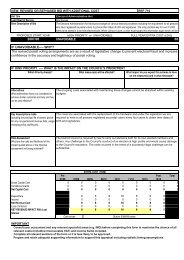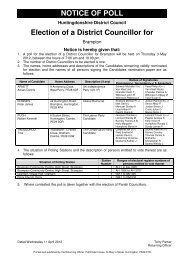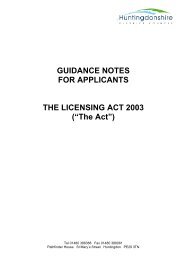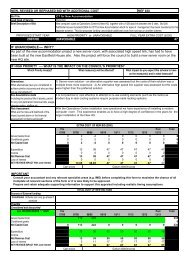Developer Contributions SPD - Huntingdonshire District Council
Developer Contributions SPD - Huntingdonshire District Council
Developer Contributions SPD - Huntingdonshire District Council
- No tags were found...
You also want an ePaper? Increase the reach of your titles
YUMPU automatically turns print PDFs into web optimized ePapers that Google loves.
The <strong>District</strong> <strong>Council</strong>’s Approach to <strong>Developer</strong> <strong>Contributions</strong> 4<strong>Huntingdonshire</strong> LDF | <strong>Developer</strong> <strong>Contributions</strong> Supplementary Planning Document4 The <strong>District</strong> <strong>Council</strong>’s Approach to <strong>Developer</strong><strong>Contributions</strong>4.1 As Local Planning Authority, <strong>Huntingdonshire</strong> <strong>District</strong> <strong>Council</strong> has a fundamental legal role and responsibilityin implementing the <strong>Developer</strong> <strong>Contributions</strong> process. In particular, the process needs to ensure that abalance is maintained between development-related and competing community infrastructure needs ofthe <strong>District</strong>.4.2 It is the <strong>District</strong> <strong>Council</strong>’s role to lead Planning Obligation (S106) negotiations, to notify developers of theirCIL liabilities, and to ensure that funds provided by developers are spent as planned in conjunction withthe agreed requirements of other authorities and implementation agencies. These may include, forexample, education and transport requirements of Cambridgeshire County <strong>Council</strong>, and health servicerequirements of the Primary Care Trust or successor organisations.Consultation, Negotiation and Notification4.3 The <strong>District</strong> <strong>Council</strong>’s Planning Service leads the <strong>Developer</strong> <strong>Contributions</strong> process, with input from a rangeof other <strong>District</strong> <strong>Council</strong> service areas, partner authorities and other public bodies.4.4 Whilst the guidance provided in this <strong>Developer</strong> <strong>Contributions</strong> <strong>SPD</strong> aims to be as clear as possible,developers will benefit from seeking early negotiations with Planning Services officers to agree planningobligations and understand their CIL liabilities prior to submitting planning applications.4.5 Negotiations will include consultation with other <strong>District</strong> <strong>Council</strong> service areas where appropriate (e.g.where open space or affordable housing is to be provided) and others including Cambridgeshire County<strong>Council</strong> regarding contributions or obligations relating to their responsibilities (e.g. transport and education).4.6 The benefits of this approach include:It ensures that developers are aware of the scale of likely contributions required for a proposeddevelopment at the earliest opportunity.It assists in determining project viability.It provides greater clarity and certainty to the process.It minimises the timescales involved in determining affected planning applications.<strong>Developer</strong> <strong>Contributions</strong> Process4.7 Prior to submitting a Draft Heads of Terms with a planning application, developers will need to considera range of factors that influence contributions.4.8 The household size of residential developments will need to be considered in order to understand thepopulation change. The following table is taken from the Development Management DPD: ProposedSubmission 2010 and indicates the average number of people living in new dwellings according to thesize of the property.Table 3 Average Number of People per HouseholdNumber of bedrooms1 bedroom2 bedroomsAverage people per household1.211.8611
















